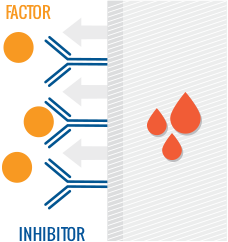Changing the Conversation

Managing life with a bleeding disorder can be an overwhelming experience for anyone. The added diagnosis of an inhibitor can be a devastating setback. Inhibitors can develop in anyone with hemophilia at any age,1 but a study comparing product classes is advancing our understanding of inhibitor development in previously untreated patients with hemophilia A. Patients and caregivers can educate themselves about inhibitors with the information that follows.
LEAD SIPPET INVESTIGATOR SPEAKS OUT ON LANDMARK RESULTS
TREATING HEMOPHILIA WITH CLOTTING FACTORS
Hemophilia is a bleeding disorder that prevents blood from clotting properly.3 People born with hemophilia are missing some or all of a protein called "clotting factor." Depending on which clotting factor is missing, a person may have hemophilia A or hemophilia B.3


Hemophilia A3
1 in 5000 males born in the US
Missing some or all
of the clotting factor viii


Hemophilia B3
1 in 30,000 males born in the US
Missing some or all
of the clotting factor ix
Factor replacement therapy is a treatment for hemophilia in which the missing clotting factor is replaced in the blood. The clotting factor (or simply, "factor") is administered via infusion (through a vein).3

THE RISK OF DEVELOPING AN INHIBITOR4
A serious complication in treating hemophilia is the development of inhibitors. Inhibitors are antibodies created by the body's immune system that can reduce the effectiveness of the infused factor used to control or prevent bleeding episodes.
Inhibitors are the main treatment challenge with FVIII today.4

ADVANCING OUR KNOWLEDGE:
PLASMA-DERIVED VS RECOMBINANT FACTOR VIII5
For nearly 30 years, recombinant and plasma-derived factor replacement products have been used to prevent bleeding, but no one had a full understanding of how they affect patients' risk of inhibitor development. Until recently, the influence of factor VIII (FVIII) concentrate on the formation of inhibitors was considered to be the same between different product classes. The latest clinical data suggest that product choice may play a role in the risk of developing inhibitors.5,6
CAN GENETIC PROFILING HELP IDENTIFY
TREATMENT CHOICE FOR PREVIOUSLY
UNTREATED PATIENTS WITH HEMOPHILIA A?
A retrospective analysis was conducted to assess whether genetic profiling would identify patients who can reduce the risk of inhibitors with recombinant FVIII.6-8
HOW HAS THE SIPPET STUDY INFLUENCED
CLINICAL PRACTICE IN THE UNITED STATES?
A survey of expert hemophilia physicians was conducted to assess to what extent the SIPPET study has influenced clinical practice of hemophilia A in the United States.2
MORE RESOURCES
VIDEO STORIES
Learn more about inhibitors and new study results from leading hematologists.
DOCTOR DISCUSSION GUIDE
Speak with your hematologist about factor replacement therapy.
ADVOCACY RESOURCES
Find more support with hemophilia advocacy organizations.
MORE RESOURCES
VIDEO STORIES
Learn more about inhibitors and new study results from leading hematologists.
DOCTOR DISCUSSION GUIDE
Speak with your hematologist about factor replacement therapy.
ADVOCACY RESOURCES
Find more support with hemophilia advocacy organizations.
STAY CONNECTED
Sign up to receive access to the full SIPPET study, as well as updates about hemophilia, inhibitors, and the latest clinical data.
It is important to note that treatment varies by patient. Be sure to consult a healthcare professional before making any treatment decisions and continue to remain informed to help facilitate care.
References:
- Medical and Scientific Advisory Council. MASAC Recommendations on Standardized Testing and Surveillance for Inhibitors in Patients with Hemophilia A and B. New York, NY: National Hemophilia Foundation; August 15, 2015. MASAC Document #236.
- Sande CM, Al-Huniti A, Ten Eyck P, Sharathkumar AA. Impact of the Survey of Inhibitors in Plasma-Product Exposed Toddlers (SIPPET) study and its post hoc analyses on clinical practice in the United States: a survey of Haemophilia and Thrombosis Research Society members. Haemophilia. 2019;25(5):764-772.
- Zimmerman B, Valentino LA. Hemophilia: in review. Pediatr Rev. 2013;34(7):289-294..
- World Federation of Hemophilia. What are inhibitors? http://www1.wfh.org/publication/files/pdf-1343.pdf. Published 2009. Accessed April 1, 2022.
- National Hemophilia Foundation. History of bleeding disorders. https://www.hemophilia.org/Bleeding-Disorders/History-of-Bleeding-Disorders. Accessed April 1, 2022.
- Peyvandi F, Mannucci PM, Garagiola I, et al. A randomized trial of factor VIII and neutralizing antibodies in hemophilia A. N Engl J Med. 2016;374(21):2054-2064.
- Peyvandi F, Mannucci PM, Palla R, Rosendaal FR. SIPPET: methodology, analysis and generalizability. Haemophilia. 2017;23(3):353-361.
- Rosendaal FR, Palla R, Garagiola I, Mannucci PM, Peyvandi F; SIPPET Study Group. Genetic risk stratification to reduce inhibitor development in the early treatment of hemophilia A: a SIPPET analysis. Blood. 2017;130(15):1757-1759.



